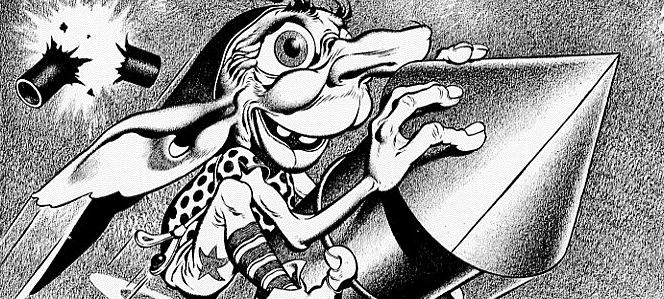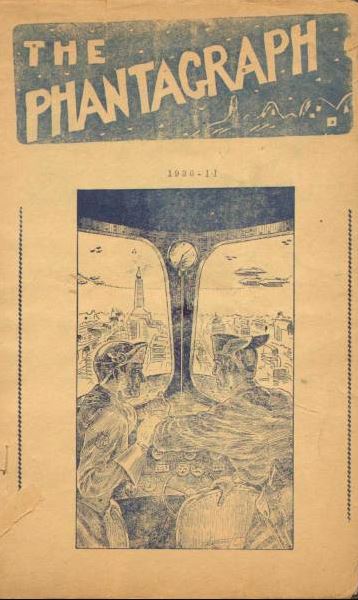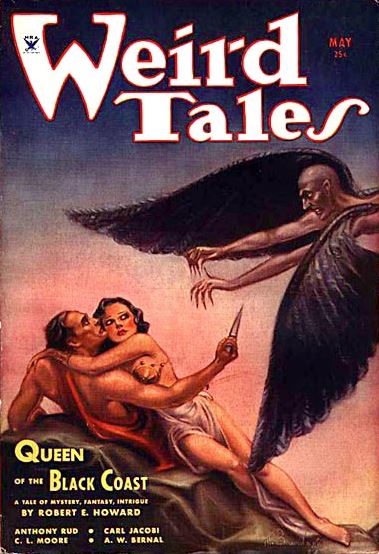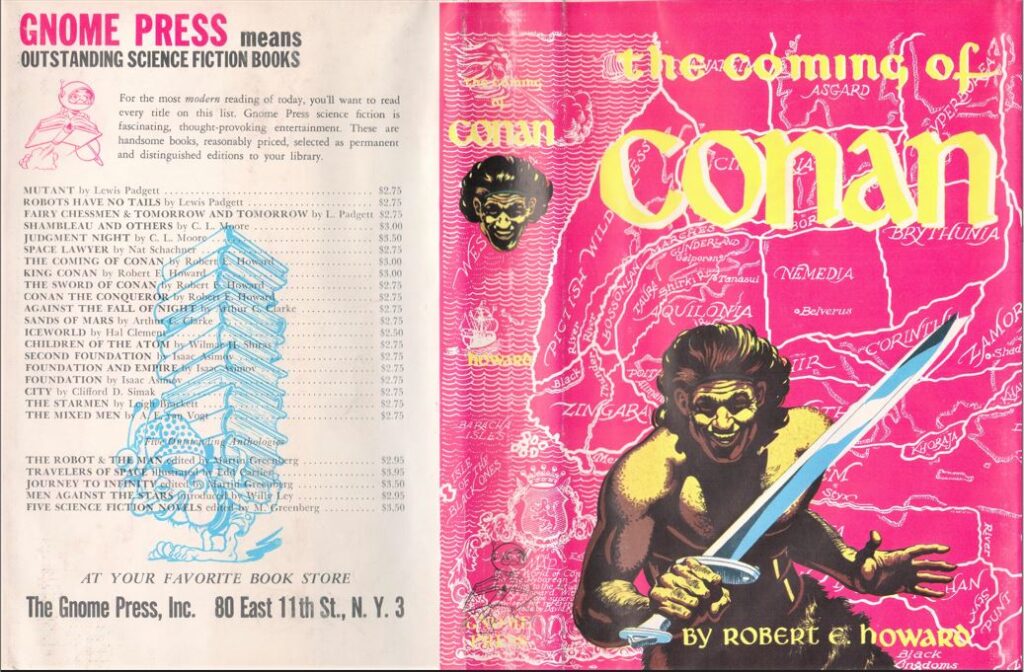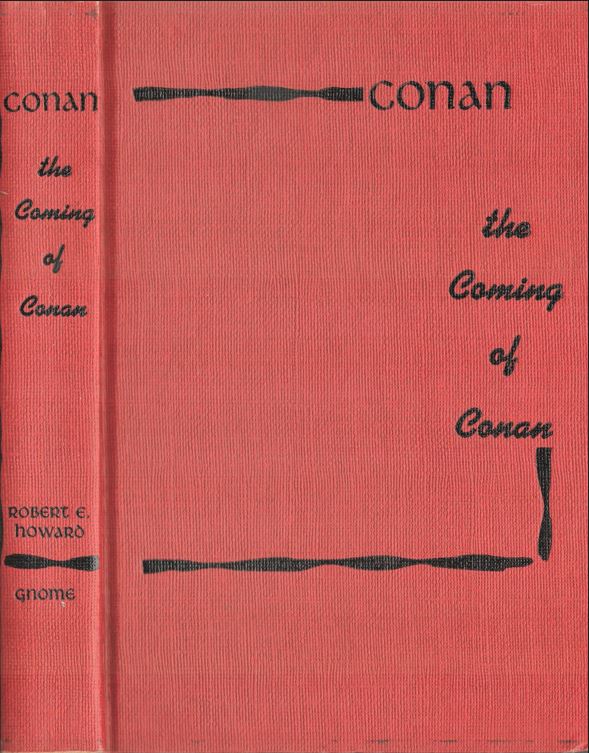Comments
The Coming of Conan is basically a grab bag of stuff from Robert E. Howard’s attic, some more desirable than others.
For most readers, the prize would be Howard’s own history of Conan’s world, “The Hyborian Age,” along with “An Informal Biography of Conan the Cimmerian,” by John D. Clark and P. Schuyler Miller, which runs as explanatory material as introductions to the Conan stories. (The first book written by Jack Chalker, CHALKER himself, was An Informal Biography of Scrooge McDuck. Conan’s influence ran deep in the fan community.) “The Hyborian Age” ran in the early fanzine The Phantagraph in 1935 and 1936, and then got bundled in a chapbook of the same name, published by a group of fans under the name of the LANY Cooperative. The Hyborian Age chapbook is one of the highest of high-end collectibles these days, and if you can track down a copy expect to pay more than for all seven Gnome Conans combined.
Howard, for all his fame and talent, wrote numerous stories that no contemporary editor would buy. Sometimes they sold after a rewrite, sometimes only a fanzine wanted them. Such was the fate of “The Frost-Giant’s Daughter.” Note the hyphen. When it didn’t sell, Howard rewrote it with different characters and retitled it “The Frost King’s Daughter.” For whatever reason, the title was changed to “Gods of the North” when it appeared in the March 1934 issue of the fanzine The Fantasy Fan. After L. Sprague de Camp was given a box full of unsold Howard stories by the Howard estate’s agent, he rewrote three Conan stories to acceptability and sold them to Lester del Rey for new magazines he was editing. “The Frost Giant’s Daughter” appeared in the third issue of Fantasy Fiction (nee Fantasy Magazine), August 1953. Somebody dropped the hyphen, leading to bibliographical hysterics. Howard’s original version has been found and reprinted in a number of volumes, all of which keep the hyphen to make it distinctive for the cognoscenti.
Robert E. Howard had been selling to Weird Tales a full seven years before his first Conan story appeared. Thirty stories and twenty-three poems appeared in that span. He sold numerous stories to other pulps in those years as well, but pulp rates were brutal. Howard earned less than $5000 total through writing from 1926 through 1932, a marginal living even by Depression standards. All pulp writers sought the comfort of a popular series character that readers would clamor for and perhaps have editors raise their rates to obtain. Howard had some success with Solomon Kane, but a Puritan adventurer didn’t engage his own obsessions. He tried again with Bran Mak Morn, the king of the Picts, and Kull, king of Atlantis. Neither clicked, but Kull’s style and sensibility were so close to Conan that “The Phoenix on the Sword” – the first Conan story – was rewritten out of an unsellable Kull tale. That made Kull a natural filler to bulk out a book of Conan odds and ends.
Kull is mentioned nowhere on the flaps, so readers must have been surprised that the first three entries in The Coming of Conan were two of the three Kull stories plus the only Kull poem. Worse, all three Kull stories had already been published by Arkham House in 1946 as part of the Howard collection Skull-Face and Others. Then again, so had two of the Conan stories here, “The Tower of the Elephant” and “Rogues in the House.” Greenberg was making good his promise to publish all the Conan material, even mere associational works.
Gnome Notes
The novel Conan the Conqueror launched the Conan series in 1950. Although Greenberg had planned to release two Conan titles a year, the second book, The Sword of Conan took until 1952 to follow. That book contained the stories set in Conan’s youth and its successor, King Conan, appeared in the spring of 1953 with the chronologically later stories. We know that King is the third Gnome Conan volume because L. Sprague de Camp says so in his Introduction. We know that Coming is the fourth Gnome Conan volume because it says so on the front flap. Library of Congress registration dates confirm the sequence, with Coming not appearing until late October 1953. How, then, could ESHBACH and CHALKER and KEMP all state that Coming appeared first? And that Coming and King were released back-to-back? There is no evidence to support that and piles of evidence that it isn’t true.
For example, the back flap and an interior page in King displays only Conqueror and Sword. King’s back panel lacks The Robot and the Man, Iceworld, Against the Fall of Night, Children of the Atom, Second Foundation, and Mutant, each of which by my dating follow it but precede Coming. All are on Coming’s back panel. The first review of King appears in the October 1953 Dynamic Science Fiction. No review of Coming appears before September 1954.
Coming is indisputably the fourth book in the series. And yet, in true Gnome fashion, that makes no sense either. Surely the volume that became titled Conan the Barbarian, featuring the few major Conan stories Gnome had not yet published, would logically be the fourth book, with Coming sweeping up these leftover dregs of Howard’s carrier, as a final volume for the Howard completist. Yet Barbarian appeared a full year after Coming. Suspension of disbelief was not limited to the material Gnome published. It must be applied to Gnome’s methods as well.
Dave Kyle’s map of Hyboria does not appear on the endpapers, but is used as background to the menacing Conan on the cover drawn by Frank Kelly Freas, whose name is spelled correctly for the first time and who depicts Conan properly as a barbarian Wildman for the first time on a Gnome cover. Additionally, the misspelled designation “The Hyborean Age,” which had appeared on the earlier Gnome Conans, is finally conspicuously missing on Coming’s title page.
Reviews
Villiers Gerson, New York Times Book Review, June 13, 1954
Filled the clash of swords, sorcery, and intrigue, they have a verve and dash seldom found in such thud-and-blunder stories. An unusual adult fairy tale well designed to while away an evening.
Damon Knight, Future Science Fiction, October 1954
Howard had the maniac’s advantage of believing everything he wrote.
Contents and original publication
• “Untitled introduction,” L. Sprague de Camp (original to this volume).
• “Howard’s Letter to P. Schuyler Miller” (original to this volume).
• “H. P. L. Letter to Donald Wollheim” (In Robert E. Howard, The Hyborian Age, Los Angeles: LANY Cooperative Publications, 1938).
• “The Hyborian Age,” Robert E. Howard and John D. Clark (based on material by Howard in the fanzine The Phantagraph, Spring, August, and October/November 1936).
• “The Shadow Kingdom” (Weird Tales, August 1929).
• “The Mirrors of Tuzun Thune” (Weird Tales, September 1929).
• “The King and the Oak” (poem from Weird Tales, February 1939).
• “An Informal Biography of Conan the Cimmerian,” John D. Clark and P. Schuyler Miller (excerpt, adapted from “Probable Outline of Conan’s Career,” in Robert E. Howard, The Hyborian Age, Los Angeles: LANY Cooperative Publications, 1938).
• “The Tower of the Elephant” (Weird Tales, March 1933).
• “The God in the Bowl” (rewritten by L. Sprague de Camp from Howard’s unpublished manuscript and published in Space Science Fiction, September 1952).
• “Rogues in the House” (Weird Tales, January 1934).
• “The Frost Giant’s Daughter” (rewritten by L. Sprague de Camp from Howard’s unpublished manuscript and published in Fantasy Fiction, August 1953).
• “Queen of the Black Coast.” (Weird Tales, May 1934).
Bibliographic Information
The Coming of Conan, by Robert E. Howard, 1953, copyright registration 25Oct53, Library of Congress Catalog Card Number not given [retroactively 53-12602], 224 pages, title #36, back panel #24, $3.00. 5000 copies printed. Hardback, red cloth, spine lettered in black. Jacket design by Frank Kelly Freas. “First Edition” on copyright page. Printed by H. Wolff. Manufactured in the U.S.A. Back panel: 25 titles. Gnome Press address given as 80 East 11th St., N.Y. 3.
Variants
None known.
Images
